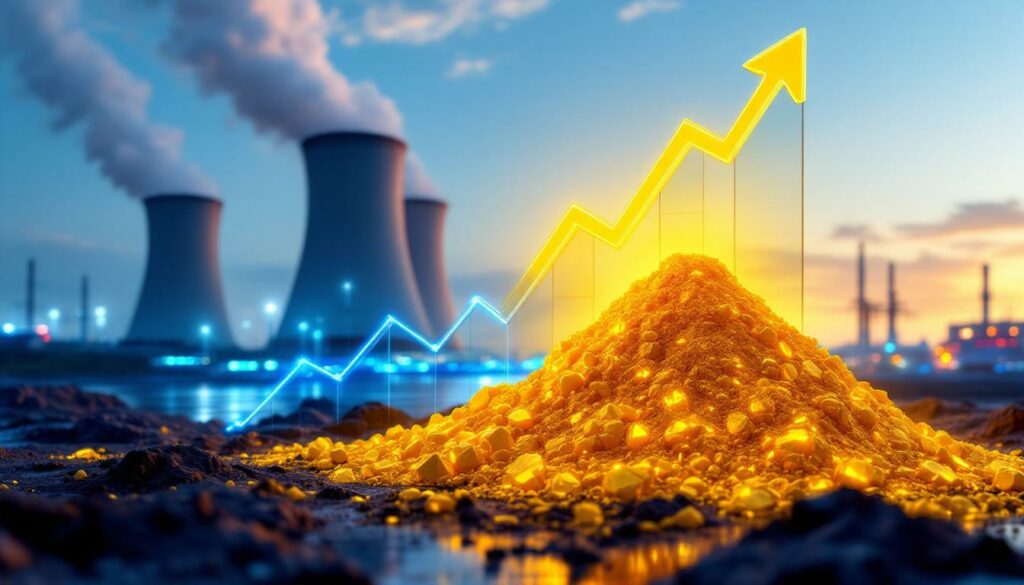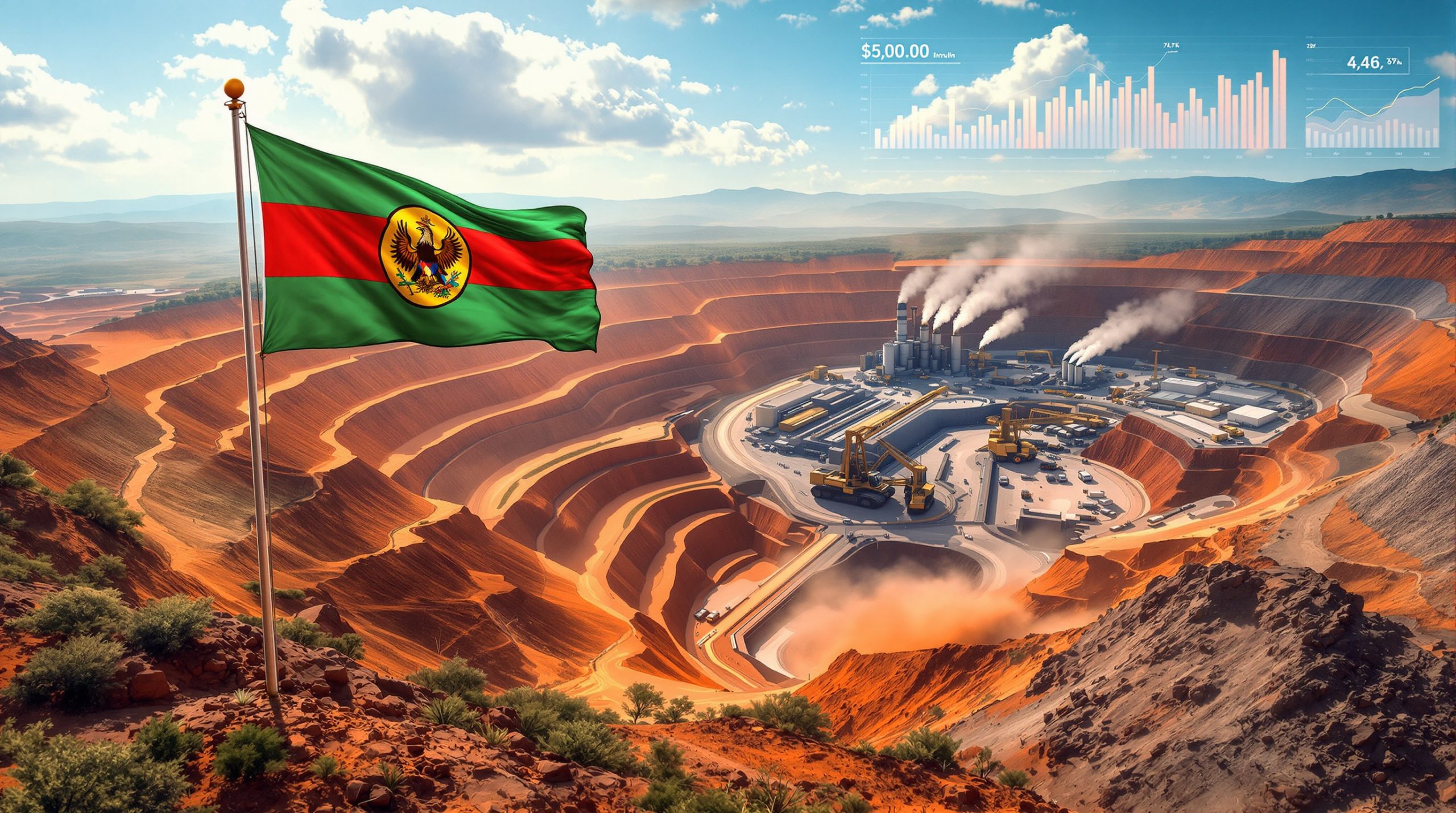What's Driving the Current Uranium Market Dynamics?
The uranium market has experienced unprecedented volatility in recent years, with prices increasing approximately 4x in both spot and term markets since 2020. Despite this substantial price appreciation, many investors and industry participants still fail to recognize the fundamental structural supply deficits driving the market. This disconnect between market perception and underlying fundamentals creates a unique investment opportunity for those who understand the uranium market analysis and investment strategy.
As uranium expert Mike Alkin noted, "There are significant structural deficits… yet [the market] has more skeptics now than ever" (VRIC Media, June 10, 2025). This skepticism persists despite clear mathematical evidence of supply shortfalls.
Understanding Market Segments and Price Mechanisms
The uranium market operates across three distinct segments, each with its own dynamics and pricing mechanisms:
- Physical spot market: Where immediate delivery transactions occur, currently trading around $73 per pound
- Term contract market: Where 80%+ of uranium actually changes hands, with price floors at $75+ and ceilings reaching $125-130
- Equity market: Where investor sentiment often disconnects from fundamentals
These segments operate with different pricing mechanisms and participant behaviors, creating inefficiencies that informed investors can potentially exploit. The spot market, while frequently cited in media coverage, represents only a small fraction of actual uranium transactions but serves as a significant sentiment driver for equity valuations.
The Structural Supply Deficit Reality
Current market conditions reveal several critical factors creating persistent supply deficits:
- Global production capacity significantly below reactor requirements by 30-40 million pounds annually
- Limited new mine development in the pipeline, with most major projects still in permitting stages
- Extended timelines for bringing new projects online (typically 7-10+ years)
- Absence of major secondary supply sources that existed in previous cycles
- Geopolitical constraints affecting uranium flow from East to West
As Justin Huhn emphasized, "Replacement rate contracting hasn't happened yet… supply deficits are mathematical" (VRIC Media, June 10, 2025). This underlying reality creates a foundation for continued price appreciation regardless of short-term uranium volatility insights.
How Are Geopolitical Factors Reshaping Uranium Supply Chains?
The global uranium supply landscape is undergoing a fundamental transformation driven by geopolitical realignments and security concerns. These shifts are creating new challenges for Western utilities while potentially benefiting producers in politically stable jurisdictions.
The East-West Supply Imbalance
A critical dynamic is emerging in global uranium flows:
- Approximately 2/3 of uranium production occurs in Eastern nations (Russia, Kazakhstan, Uzbekistan)
- Roughly 2/3 of uranium consumption happens in Western countries (US, France, UK, etc.)
- Eastern production increasingly flowing to Eastern consumers, particularly China
- Western utilities facing growing competition for available supply
This imbalance is exacerbated by strengthening political and economic ties between Eastern producers. Kazakhstan's growing alignment with Chinese and Russian interests is particularly significant given its position as the world's largest uranium producer.
Russia's Complex Role in the Nuclear Fuel Cycle
Russia's position in the nuclear fuel supply chain extends far beyond uranium mining:
- Controls 40-45% of global enrichment capacity
- Manages 30% of conversion services
- Produces approximately 15% of mined uranium
- Faces upcoming US uranium tariff risks
- Is actually a net buyer of uranium to feed its enrichment facilities
This multifaceted role means that even if the Russia-Ukraine conflict were resolved tomorrow, the structural supply challenges would persist. Russia's enrichment dominance creates a more complex dynamic than many market observers recognize.
Regional Production Challenges and Opportunities
Multiple uranium-producing regions face unique challenges that impact global supply:
Kazakhstan:
- World's largest producer (approximately 40% of global supply)
- Experiencing sulfuric acid supply constraints that limit production expansion
- Management instability and leadership changes creating operational uncertainty
- Growing alignment with Chinese and Russian interests reducing Western access
Niger:
- Political instability following coup in 2023
- Uncertain production outlook for French-operated mines
- Historical importance as a uranium supplier to Europe now in question
- Supply redirection potentially benefiting Eastern consumers
United States:
- Minimal current production despite past capability
- Regulatory and economic hurdles for domestic producers
- Growing policy support for nuclear energy and domestic uranium
- Accelerated permitting for projects like Energy Fuels' New Mexico operations
Why Aren't Utilities Contracting at Replacement Rates?
Despite rising prices and supply constraints, many utilities have been reluctant to enter into long-term contracts at current price levels. This behavior seems counterintuitive given the looming supply shortfalls but can be explained by several factors.
The Complacency Factor
Utility fuel buyers have operated in an environment of abundant supply for decades:
- Post-Chernobyl and post-Fukushima inventory buildups created surplus supplies
- Russian "Megatons to Megawatts" program (1993-2013) provided 20 million pounds annually
- Kazakhstan's production surge from 5 million to 60+ million pounds flooded markets
- Historical ability to secure uranium whenever needed created institutional complacency
This long-term abundance has created a psychological barrier to accepting new market realities. Many utility fuel buyers have never operated in a true seller's market and struggle to adjust their procurement strategies accordingly.
The Procurement Sequence Challenge
Nuclear fuel procurement follows a specific sequence that impacts uranium buying:
- Utilities prioritize securing enrichment and conversion services first
- These services are at or near record high prices
- Uranium feed stock is typically the final component secured
- Many conversion contracts already signed lack uranium feed commitments
As Grant Isaac of Cameco explained, "Utilities buy backwards—prioritize conversion/enrichment first" (VRIC Media, June 10, 2025). With limited budgets and already high costs for enrichment and conversion, utilities face sticker shock when finally moving to secure uranium supplies.
The Market Equilibrium Shift
The balance of power in contract negotiations is shifting dramatically:
- Major producers holding firm on price floors ($75+)
- Price ceilings in market-related contracts reaching $125-130
- Utilities losing leverage as inventories deplete
- Smaller utilities with less coverage facing greatest risk
This power shift is creating a bifurcated market where large, well-capitalized utilities can secure supply while smaller players face increasing challenges. The eventual scramble by these smaller utilities could accelerate price discovery in the coming years.
What's the Outlook for Future Uranium Supply?
The uranium supply landscape faces significant constraints that will challenge the market's ability to meet growing demand. These limitations are structural and will take years, if not decades, to resolve.
Limited New Production Sources
Future uranium supply faces several constraints:
- Few major projects in advanced development stages
- Extended timelines for permitting, financing, and construction
- Higher costs for new production versus historical sources
- Jurisdictional challenges in key mining regions
The industry's ability to respond to price signals is severely constrained by these factors. Unlike commodities with shorter development timelines, uranium mines typically require 7-10+ years from discovery to production, creating an extended supply response lag.
The African Potential and Limitations
Several African nations represent potential supply sources but face significant challenges:
- West African projects could contribute 2-3 million pounds annually
- Namibia hosts several significant deposits with expansion potential
- Jurisdictional and political risks create uncertainty for investment
- Infrastructure and logistics challenges in remote regions increase costs
The recent coup in Niger demonstrates the political vulnerabilities in the region. With France historically dependent on Niger for uranium supplies, this instability creates additional supply chain risks for European utilities.
Canadian Projects: Timeline Reality Check
Canada's Athabasca Basin hosts world-class uranium deposits, but development timelines exceed most market expectations:
- NextGen's Arrow and Denison's Phoenix projects still in permitting stages
- Financing not yet secured for full-scale development
- Realistic timelines extend well beyond 2028 for new production
- Strategic value may lead companies to delay development for optimal timing
Justin Huhn noted that "NextGen's Arrow/Dennis projects are critical but delayed" (VRIC Media, June 10, 2025). These high-grade projects represent significant future supply potential, but their contribution remains years away.
Australia's Untapped Resources
Australia holds significant uranium reserves but faces challenges:
- Regulatory and political hurdles in certain states (particularly Western Australia)
- Environmental permitting complexities extending development timelines
- Higher production costs than some competing regions
- Potential for increased production under supportive policies remains unrealized
Australia's conflicted relationship with uranium mining—hosting substantial resources while maintaining restrictive policies in some regions—creates uncertainty for producers looking to develop new projects. In Namibia, the recent Paladin uranium halt demonstrates how even established producers can face operational challenges.
How Is Nuclear Power's Renaissance Impacting Uranium Demand?
The nuclear energy sector is experiencing renewed interest and support globally, creating additional demand drivers beyond existing reactors. This renaissance comes after a decade of post-Fukushima uncertainty and represents a significant shift in the industry's prospects.
Policy Reversals in Europe and Beyond
Countries previously committed to nuclear phase-outs are reconsidering:
- Germany accepting nuclear as "green" energy after years of opposition
- Spain potentially reversing planned closures of operating reactors
- Multiple European nations exploring new nuclear builds amid energy security concerns
- Life extensions for existing plants becoming more common and economically attractive
These policy shifts reflect growing recognition of nuclear's role in both energy security and decarbonization efforts. The Russian invasion of Ukraine accelerated this reassessment as European nations sought to reduce dependency on Russian natural gas.
The AI and Data Center Power Demand Factor
Emerging technology sectors are creating new demand for reliable, carbon-free electricity:
- Meta securing a 20-year power purchase agreement from Clinton nuclear plant (Chicago Sun Times, 2025)
- Microsoft partnering with Three Mile Island for dedicated power supply
- Tech companies validating nuclear as reliable power source for 24/7 operations
- Data centers requiring 24/7 reliable electricity at scale
- Potential for tech companies to directly invest in nuclear projects or fuel supply
While Mike Alkin cautioned that "Big tech validates nuclear… but demand is gravy to structural deficits" (VRIC Media, June 10, 2025), these developments nonetheless represent a significant vote of confidence in nuclear energy's future.
Small Modular Reactors Moving from Concept to Reality
SMR technology is transitioning from theoretical to practical applications:
- Darlington facility in Ontario breaking ground on BWRX-300 deployment
- Multiple U.S. utilities advancing SMR license applications
- Utilities securing uranium supply for these projects, albeit in limited quantities initially
- Potential for accelerated deployment compared to conventional reactors
These developments represent a potential paradigm shift in nuclear deployment, with smaller, standardized designs potentially overcoming the cost and schedule challenges that have plagued conventional nuclear construction.
What Investment Strategy Makes Sense in This Market?
The unique characteristics of the uranium market require a specialized investment approach that accounts for market inefficiencies and structural drivers. Understanding these dynamics can help investors navigate the volatility inherent in this sector.
Focus on Conditions, Not Catalysts
The most effective uranium investment strategies emphasize:
- Understanding the fundamental supply-demand imbalance
- Recognizing the inevitability of higher prices to incentivize production
- Patience through market volatility and sentiment swings
- Positioning ahead of utility contracting cycles
As Justin Huhn advised, "Focus on conditions, not catalysts… math dictates higher prices" (VRIC Media, June 10, 2025). This approach requires a longer time horizon than many investors typically employ but aligns with the structural nature of the uranium market opportunity.
US Uranium Producer Outlook
US-based uranium companies face a complex but potentially favorable environment:
- Supportive policy environment under recent administrations
- Accelerated permitting for some projects, including US ISR production update
- Higher production costs than global competitors (particularly Kazakhstan)
- Strategic importance in domestic energy security increasingly recognized
- Potential premium valuation as supply security concerns grow
The combination of national security considerations and growing nuclear support creates a potentially favorable environment for domestic producers despite their cost disadvantages relative to international competitors.
Evaluating Development-Stage Projects
When assessing uranium development projects, investors should consider:
- Realistic timelines for permitting, financing, and construction
- Jurisdictional risks and local support for uranium mining
- Production cost profile relative to projected long-term prices
- Management team experience in bringing mines to production
- Potential for strategic acquisition by larger entities
Projects in the Athabasca Basin deserve particular attention given their exceptional grades and relatively stable jurisdiction, though investors should recognize that even these world-class projects face extended development timelines.
The Contract Structure Evolution
The structure of uranium supply contracts is evolving in ways that impact producers:
- Increasing market-related pricing components versus fixed pricing
- Higher price floors in new contracts ($75+ versus historical $30-40)
- Wider collars between floor and ceiling prices ($75-130 range)
- Producers gaining leverage in negotiations after decades of buyer dominance
- Utilities gradually accepting higher price requirements as necessity
These evolving contract structures will likely benefit producers while creating challenges for utilities accustomed to more favorable terms. Investors should pay attention to company disclosures regarding contract structures as indicators of market evolution.
What Makes This Uranium Cycle Different from Previous Ones?
The current uranium market cycle differs fundamentally from previous periods in ways that could impact price discovery and investment outcomes. Understanding these differences is crucial for setting appropriate expectations.
Absence of Major Secondary Supply Sources
Unlike previous cycles, current market conditions lack significant secondary supply:
- No "Megatons to Megawatts" program providing 20 million pounds annually
- Limited underfeeding from enrichers due to capacity constraints
- Depleted above-ground inventories following years of production deficits
- Few major mines in late-stage development to address shortfalls
These factors create a more sustained supply challenge than in previous cycles, when secondary sources could buffer market imbalances.
Slower but More Sustainable Price Appreciation
The current price trend shows different characteristics from the 2003-2007 spike:
- More gradual price increases compared to previous cycle's parabolic rise
- Stronger fundamental support from supply-demand imbalance
- Less speculative activity driving price movements
- Greater utility awareness of long-term supply challenges
Mike Alkin observed that "Prices rise slower but with stronger fundamentals" (VRIC Media, June 10, 2025), suggesting a more sustainable trend than the boom-bust cycle that characterized the 2007 peak and subsequent collapse.
The Contracting Catalyst Still Ahead
Despite several years of price appreciation, a key market driver remains in the future:
- Replacement rate contracting has not yet fully materialized
- Major utilities still operating below historical contracting levels
- Eventual contracting surge likely to accelerate price discovery
- Potential for price volatility when smaller utilities scramble for supply
This pending contracting cycle represents a significant potential catalyst for the uranium market, particularly for producers able to secure favorable terms in a supply-constrained environment.
FAQs About Uranium Market Investment
How does the spot price of uranium relate to equity performance?
The spot price serves as a sentiment indicator for uranium equities despite representing only a small portion of actual uranium transactions. While equities can temporarily disconnect from spot price movements, they generally follow the trend over time. The spot market's limited liquidity means small trading volumes can create significant price movements, which can amplify equity volatility.
Investors should recognize that many producers secure the majority of their sales through term contracts at prices that may differ significantly from spot. Company-specific factors such as production costs, jurisdiction, and contract portfolio can lead to divergent equity performance even amid broader market trends.
What impact would Russian conflict resolution have on uranium prices?
Contrary to some market assumptions, a resolution to the Russia-Ukraine conflict would likely have limited impact on uranium supply dynamics. Russia is actually a net buyer of uranium to feed its enrichment facilities and domestic reactor fleet. The structural supply deficit exists independently of the conflict, and Russian export capacity to Western markets was already limited by regulations and sanctions.
More significant than the conflict itself is Russia's dominant position in conversion and enrichment services, which creates complex interdependencies in the nuclear fuel cycle. Western efforts to reduce reliance on Russian services will require time and substantial investment.
How might AI and data centers influence uranium demand?
While AI and data centers represent a potential demand growth driver, their primary impact has been de-risking the existing nuclear fleet by creating baseload power demand. Tech companies may eventually become more directly involved in the nuclear fuel cycle through investments or partnerships, but this remains speculative. The structural supply deficit exists independent of this potential demand growth.
The Meta agreement to purchase power from the Clinton nuclear plant for 20 years (Chicago Sun Times, 2025) represents a significant validation of nuclear energy's reliability and environmental attributes. However, investors should view such developments as supplementary to the core supply-demand imbalance rather than primary drivers.
Why haven't uranium prices risen more dramatically given the supply deficit?
The uranium market operates with significant inefficiencies and information asymmetry. Utility fuel buyers have historically had abundant supply options and have been slow to recognize the structural changes in the market. Price discovery is ham
Curious About the Next Big Mineral Discovery?
Discover why major mineral discoveries lead to significant market returns by exploring Discovery Alert's dedicated discoveries page, powered by the proprietary Discovery IQ model that transforms complex mineral data into actionable insights. Begin your 30-day free trial today at Discovery Alert to position yourself ahead of the market.




